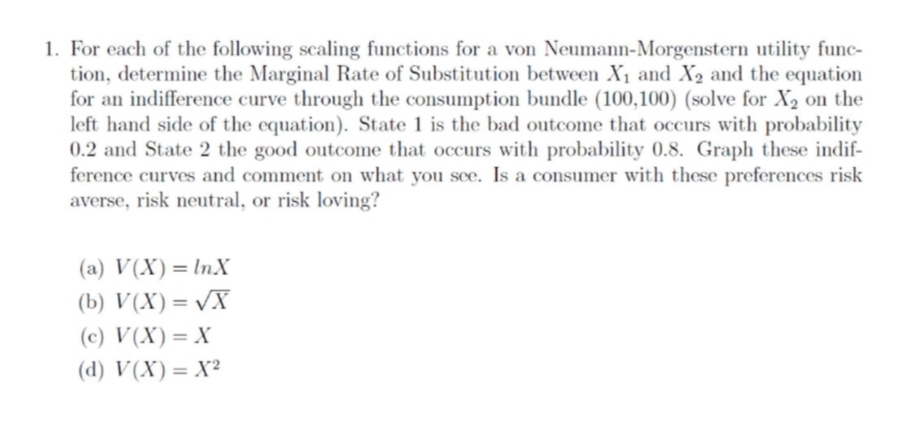1. For each of the following scaling functions for a von Neumann-Morgenstern utility func- tion, determine the Marginal Rate of Substitution between X1 and X2 and the equation for an indifference curve through the consumption bundle (100,100) (solve for X2 on the left hand side of the equation). State 1 is the bad outcome that occurs with probability 0.2 and State 2 the good outcome that occurs with probability 0.8. Graph these indif- ference curves and comment on what you see. Is a consumer with these preferences risk averse, risk neutral, or risk loving? (a) V(X)=lnX (b) V(X)= vX (c) V(X)= X (d) V(X)= X? %3D
1. For each of the following scaling functions for a von Neumann-Morgenstern utility func- tion, determine the Marginal Rate of Substitution between X1 and X2 and the equation for an indifference curve through the consumption bundle (100,100) (solve for X2 on the left hand side of the equation). State 1 is the bad outcome that occurs with probability 0.2 and State 2 the good outcome that occurs with probability 0.8. Graph these indif- ference curves and comment on what you see. Is a consumer with these preferences risk averse, risk neutral, or risk loving? (a) V(X)=lnX (b) V(X)= vX (c) V(X)= X (d) V(X)= X? %3D
A First Course in Probability (10th Edition)
10th Edition
ISBN:9780134753119
Author:Sheldon Ross
Publisher:Sheldon Ross
Chapter1: Combinatorial Analysis
Section: Chapter Questions
Problem 1.1P: a. How many different 7-place license plates are possible if the first 2 places are for letters and...
Related questions
Question
10

Transcribed Image Text:1. For each of the following scaling functions for a von Neumann-Morgenstern utility func-
tion, determine the Marginal Rate of Substitution between X1 and X2 and the equation
for an indifference curve through the consumption bundle (100,100) (solve for X2 on the
left hand side of the equation). State 1 is the bad outcome that occurs with probability
0.2 and State 2 the good outcome that occurs with probability 0.8. Graph these indif-
ference curves and comment on what you see. Is a consumer with these preferences risk
averse, risk neutral, or risk loving?
(a) V(X)=lnX
(b) V(X)= vX
(c) V(X)= X
(d) V(X)= X?
%3D
Expert Solution
This question has been solved!
Explore an expertly crafted, step-by-step solution for a thorough understanding of key concepts.
Step by step
Solved in 2 steps with 2 images

Recommended textbooks for you

A First Course in Probability (10th Edition)
Probability
ISBN:
9780134753119
Author:
Sheldon Ross
Publisher:
PEARSON


A First Course in Probability (10th Edition)
Probability
ISBN:
9780134753119
Author:
Sheldon Ross
Publisher:
PEARSON
